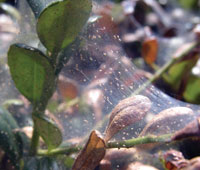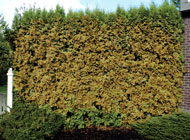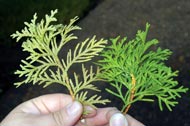|

Two-spotted mite infestation on boxwood. Spider MitesDownload a PDF of this articleDescriptionSpider mites are not insects but are more closely related to spiders. Mites are Arachnids that have eight legs while insects have six. Many spider mite species are plant feeders but some are predators and feed on other mites. Spider mite appearance varies with species but generally they are very tiny, 1/50 inch in size. Their colors range from red to yellow and green depending on species and also seasonal changes. Many spider mites produce fine webbing especially when populations are high. Plants AffectedTwo spotted mites: These mites attack the foliage of ornamentals such as dogwood, euonymus, roses, spiraea, and perennials, vegetables and fruits. Spruce spider mites: These mites attack conifers such as arborvitae, cypress, juniper, pines, and spruce. Skimmia mites: As the name suggests only attack skimmia. European red mite: Red mites are common pests of fruit trees such as apple. Symptoms/DamageSpider mites damage plants by feeding on the leaves. They suck out plant sap and chlorophyll resulting in foliage looking, speckled, yellow, or bronzed cast. Leaves may drop prematurely. The resulting reduction in photosynthesis causes loss of vigor. Severe infestations can result in plant death. Life CycleSpider mite species seem to be either warm weather or cool weather active pests. The two spotted and European red mites do best in hot dry summer weather. The spruce spider mites do best in cool late spring and fall weather. Spruce spider mites over winter as bright red eggs and a dormant treatment is a good time to reduce egg populations. The two spotted mites over winter as adults. Generally mites hatch in the spring and start feeding on their particular host plants. There may be 8 to 10 overlapping generations per year. Mites reproduce more rapidly as temperatures increase and can have generation times as short as 5 to 10 days. ManagementDetection before damage is noticed is important. Tiny spider mites can be detected by a 10x hand lens or by shaking foliage over a white piece of paper. Mites can be seen moving slowly on the paper. Treating mites with the wrong product can result in severe mite outbreaks. CulturalWash mites off the foliage of plants during the summer with a strong stream of water at weekly intervals. This removes dirt and dust which favor an increase in mite numbers. Water trees properly as drought stressed plants are more susceptible to mites. Don't over fertilize plants with mite problems with heavy applications of nitrogen. OrganicSoap and oil applications will help keep spider mites in check. Repeat applications are necessary starting in late spring and continue to fall. Complete coverage of the foliage including treating the underside of the leaves is essential for control. Predator mites can be released to help control plant feeding mites. ChemicalSpider mites are not effectively controlled by regular insecticides. A specific miticide gives best control but few products are available to the homeowner. There are several effective systemic products that are long lasting and available to the commercial applicator. Apply superior (light weight) oil in the dormant season to control spruce spider mite eggs on conifers like arborvitae and pines. Do not apply oil to a blue spruce. |

Arborvitae hedge with severe mite infestation. 
Diseased arborvitae as compared to a healthy plant. |
|
Home |
Services |
The Arbor Advisor |
Garden Calendar |
About Us |
Fact Sheets |
Contact Us |
Site Map Collier Arbor Care Portland 503-722-7267 Vancouver (360) 693-6056 Site contents and design ©2013 Collier Arbor Care |





